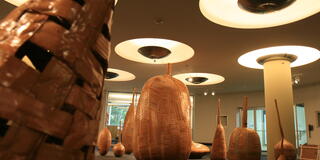Night Blooming: Sculptures by Ann Weber

August 4 – October 5, 2008
....when the season's first hearth fires
mingle their exhalations
with night-blooming vegetation,
snow and silence ahead of you....
—August Kleinzhaler, from "September"
In Night Blooming, Ann Weber brings together a series of gourd-like sculptures and elements from her early clay works to create a moody, fairytale garden that reminds us of our vulnerability and complicated relationship with nature.
While her materials (flattened cardboard, staples and shellac) embrace the values of eco-art, these works retain formal and aesthetic clarity, bringing to light nature’s oppositions—female and male, line and circle, gravity and levity—and their required intimacies. Pushing her materials to their limits, these sculptures have the warm sheen of polished bronze and the weighty, lush presence of ripened fruit.
Dewitt Cheng wrote in Artweek, February 2007: "Ann Weber’s large sculptures made from woven strips of cardboard synthesize ancient and modern, craft and high art. The biomorphic gourd shapes suggest traditional basketry, but also, with their human size, their open grids and peepholes, pre-industrial coffins or cages, and their probing necks (smokestacks or chimneys), they’re imbued with life and as anthropomorphic as Giorgio Morandi’s bottles."
In addition to this central installation, the gallery presents a number of Weber’s wall-mounted studies titled "Both." Using the same materials as her sculptures, Weber uses these studies to once again explore oppositions as well as the formal issues behind two- and three-dimensional composition.
About the Artist
Ann Weber, an award-winning sculptor who began working with ceramics, has exhibited widely in California, including the Fresno Museum, Sonoma Valley Museum of Art, San Jose Museum of Art, and the Oakland Museum. Her commissioned bronze works can be seen in Phoenix, Denver, and Sacramento among others.
Artist Statement
My artistic journey began with Ceramics spending fifteen years making functional pottery on the wheel before leaving New York City for California to study with Viola Frey and Art Nelson while pursuing an MFA at California College of Arts and Crafts in Oakland.
I started working in cardboard in 1991 because I wanted to make large forms and wanted to eliminate the cumbersome process of clay and the weight of large clay objects. Using Frank Gehry’s cardboard furniture for inspiration I decided to use the same material for abstract shapes. The sculptures read as metaphors for life experiences such as the balancing acts that define our lives or how far you can go with something before it collapses. They are large primal forms that can represent seed pods, figures, architecture, relationships, pearls.
Working with a palette of simple forms: cylinders and circles, the sculptures are symbolic of male and female forms and the natural world. The resourcefulness of making beauty from a common and mundane material intrigues me.
Transforming the cardboard by casting it into bronze for public art projects enables me to explore the idea of creating something from nothing, turning straw into gold. One of the unique qualities of my public art is that the sculptures have a psychological component. Neither entirely representational or literal, but something in between, I want the viewers to bring their own associations to the artwork. I use historical and art historical references to evoke memory, relationships and morality in my sculpture. In addition to making a strong statement as a work of art, my work is accessible to people who do not have an art background. My goal is to make artwork that relates to the site, the environment, the purpose of the space and the people who will be using it.
—Ann Weber, 2008
Opening Programs
Thursday, September 4
Artist Lecture, 3 pm, Maraschi Room, Fromm Hall
Reception, 4 – 6 pm, Thacher Gallery